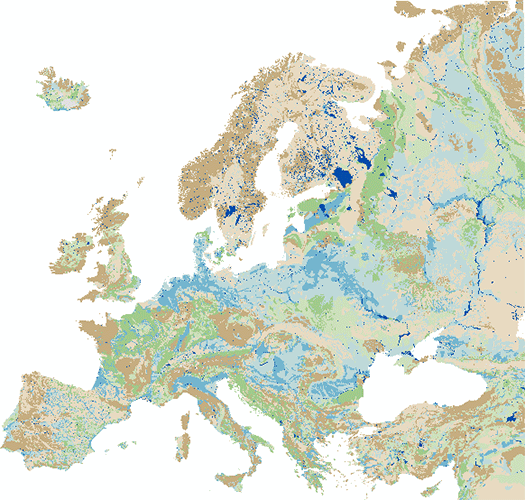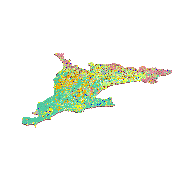Aquifer
Type of resources
Available actions
Topics
Keywords
Contact for the resource
Provided by
Years
Formats
Representation types
Update frequencies
status
Service types
Scale
-

Hydrogeological Regions provide a framework to introduce the regional hydrogeology of Canada and to connect apparently disparate studies into a broader framework. The hydrological regions are first order areas used to capture and summarize data that will help develop more detailed profiles of each region. Comparison of findings within and between regions will allow scalable extension to sub-regional and watershed scale mapping. Canada has been classified into nine principal hydrogeological regions. Each region is described briefly based on the following five hydrogeological characteristics (Heath, 1984): system components and geometry; water-bearing openings; rock matrix composition; storage and transmission; recharge/ discharge. The hydrogeological classification emphasizes major geological provinces and rock formations. Fundamental water-bearing openings and rock matrix properties help determine the quantity (storage), flux (transmission), and composition of formation waters. These same properties and any overlying sediment cover affect recharge/ discharge rates for regional formations. While regional attributes are general, a simple aquifer mapping scheme can further describe the nature and character of aquifers in each region. For example, general groundwater settings across the country could be described as has been done by USGS principal aquifers [1]. Thus the regional framework can potentially link from national scales to watershed scales by identifying typical aquifer types based on readily available geological maps that use water-bearing character as a common attribute. The nine hydrogeological regions include: Cordillera Mountains with thin sediment over fractured sedimentary, igneous and metamorphic rocks of Precambrian to Cenozoic age. Intermontane valleys are underlain by glacial and alluvial deposits of Pleistocene age. Plains (Western Sedimentary Basin) Region-wide basin of sub-horizontal Paleozoic to Cenozoic sedimentary rocks are overlain by thick glacial deposits filling buried valleys. Incised post-glacial valleys provide local relief. Shallow gas, coal, and brines may occur. Canadian Shield Undulating region of thin glacial sediment overlying complex deformed, fractured PreCambrian igneous, metamorphic and sedimentary rocks. Region contains several terrains: sedimentary basins, structural belts, and glacial-lacustrine basins. Hudson Bay (Moose River) Basin Sedimentary basin of Paleozoic to Mesozoic sub horizontal carbonate and clastic sediment covered by surficial deposits, with low relief and poor drainage. Southern Ontario Eastern Great Lakes region is underlain by gently-dipping Paleozoic, carbonate, clastic and gypsum-salt strata overlain by glacial sediments up to 200 m thick with tunnel valleys. Karst, bedrock valleys, shallow gas and brines are also important components. St. Lawrence Lowlands Lowlands underlain by shallow-dipping Paleozoic sedimentary rocks and thick glacial sediment in glacial-marine basins. Appalachian and Precambrian uplands discharge water to valleys. Shallow gas and saltwater intrusion are possible. Appalachia Upland to mountainous region with thin surficial sediment on folded Paleozoic sedimentary and igneous rocks. Range of rock types yields a wide range of water compositions. Valleys contain important alluvial aquifers. Maritimes Basin Lowlands with flat-lying, Carboniferous clastic , salt, and gypsum rocks contain shallow coal deposits. Surface glacial sediment is thin and discontinuous. Salt water intrusion is possible. Permafrost Arctic islands and most areas north of 60o contain frozen ground affects on groundwater flow. Diverse topography and geology define sub-regions of sedimentary basins and crystalline rocks. Glacial sediment is thin, discontinuous; local peat accumulations are significant.
-

A hydrogeological unit is defined as any soil or rock unit or zone that by virtue of its hydraulic properties has a distinct influence on the storage or movement of groundwater. It is considered the main dataset from the GGP point of view. Hydrogeological units are ranked into five levels (from largest to smallest): 1) hydrogeological region, 2) hydrogeological context, 3) aquifer system, 4) hydrostratigraphic unit, and 5) aquifer. Here are formal definitions for these different types of hydrogeologic units. - Hydrogeological region Hydrogeological regions are areas in which the properties of sub-surface water, or groundwater, are broadly similar in geology, climate and topography. There are 9 such regions identified in Canada (ref?). - Hydrogeological context Hydrogeological contexts are units of reporting, conceptually narrower than regions, and are additionally delineated by physiographic and hydrogeological aspects. - Aquifer system ""A heterogeneous body of intercalated permeable and poorly permeable material that functions regionally as a water-yielding hydraulic unit; it comprises two or more permeable beds [aquifers] separated at least locally by aquitards [confining units] that impede groundwater movement but do not greatly affect the regional hydraulic continuity of the system"" (Poland et al., 1972). - Hydrostratigraphic unit (HSU) ""Body of sediment and/or rock characterized by ground water flow that can be demonstrated to be distinct under both unstressed (natural) and stressed (pumping) conditions, and is distinguishable from flow in other HSUs"" (Noyes et al.) - Aquifer ""A formation, group of formations, or part of a formation that contains sufficient saturated permeable material to yield significant quantities of water to wells and springs"" (Lohman et al, 1972, p. 21). The rank attribute is used to specify the scope of the described unit. The general principle behind this specification is to allow the same data structure to apply to various types of hydrogeological units, from the local aquifer to the almost continental hydrogeological region. The dataset includes properties such as identification, physiography, geology, aquifer description and properties, water balance, groundwater use and risk. It features numerical values or a general description when no values are available. The description can also be used to add context to the numerical values. For each property, metadata identifying the source of the original data, links to similar data in GIN, and description of the processes, algorithms or methodology used to obtain these datasets will be available to complement the data. This dataset is designed to capture and represent a set of synthesized information pertaining to hydrogeological units through maps and succinct table reports. Some attributes (or properties) of the dataset are irrelevant depending of the rank of the unit. In general, this dataset is organised to include multiple properties associated with aquifers and larger hydrogeologic units. These properties are grouped into categories, which include identification, physiography, geology, aquifer description, water balance, groundwater use and risk. The numerical values associated with each of the properties can be used to create thematic maps; hence, the importance of using standardized units of measurement and definitions for these properties. When numerical values are not available, a general description may be supplied instead. The description can also be used to add context to the numerical values. Because this dataset is the cornerstone of the national view on groundwater, supplemental contextual information (metadata) must be part of the data. Thus, for each property, metadata identifying the source of the original data, links to similar data in GIN, and a description of the processes, algorithms or methodology used to obtain these datasets will be available to complement the data.
-

A newer dataset developed in 2021, called Aquifer Vulnerability to Sea Water Intrusion, has replaced this version. This dataset remains available for download for comparison purposes. This dataset was developed as part of the Risk Assessment Framework for Coastal Bedrock Aquifers project completed by Simon Fraser University, for the BC Ministry of Environment and the BC Ministry of Forests, Lands and Natural Resource Operations. Features in the dataset show the vulnerability of coastal aquifers on the Gulf Islands to salt water intrusion, based on their intrinsic susceptibility (aquifer properties such as distance from the coast and topography) and groundwater pumping (well density and type of use). This [link](http://summit.sfu.ca/item/15778) refers to the Master of Science Thesis Report prepared by Jeanette Klassen in 2015 as a component of the collaborative study between Simon Fraser University and the Province of British Columbia.
-

A newer dataset developed in 2021, called Aquifer Vulnerability to Sea Water Intrusion, has replaced this version. This dataset remains available for download for comparison purposes. This dataset was developed as part of the Risk Assessment Framework for Coastal Bedrock Aquifers project completed by Simon Fraser University, for the Ministry of Environment and the Ministry of Forests, Lands and Natural Resource Operations. Features in the dataset show the vulnerability of coastal aquifers on Salt Spring Island to salt water intrusion, based on their intrinsic susceptibility (aquifer properties such as distance from the coast and topography), groundwater pumping (well density and type of use) and coastal hazard (coastal morphology and vulnerability to flooding from storm surges). This [link](http://summit.sfu.ca/item/15778) refers to the Master of Science Thesis Report prepared by Jeanette Klassen in 2015 as a component of the collaborative study between Simon Fraser University and the Province of British Columbia.
-

Polygon features representing the vulnerability of coastal aquifers to sea water intrusion.
-

Die IHME1500 v1.2 ist ein durch Digitalisierung der 25 publizierten Kartenblätter der Internationalen Hydrogeologischen Karte von Europa im Maßstab 1:1.500.000 (IHME1500) entstandener Vektor-Datensatz. Dieser Datensatz wurde um fünf unpublizierte, ebenfalls digital erfasste IHME1500-Kartenblätter erweitert, um einen kompletten Blattschnitt zu erstellen. Der Datensatz besteht aus ausgewählten Fachthemen der IHME1500 mit folgenden Inhalten:- Aquifertypen (Flächen): Unterscheidung von sechs Typen hinsichtlich Produktivität und Hohlraumart der Grundwasserleiter.- Lithologie (Flächen): Lithologische Klassifizierung der Grundwasserleiter in fünf Aggregationsstufen.- Meerwasserintrusion (Flächen): Gebiete mit Versalzungserscheinungen im Grundwasser durch eindringendes Meerwasser.- Tektonische Störungen (Linien): Geologische Lineamente unterschieden in fünf Klassen mit gesicherten bzw. vermuteten Störungen und Überschiebungen und den Grenzen von Zerrüttungszonen auf Island. Die Vektordaten IHME1500 v1.2 beinhalten eine Bereinigung von Inkonsistenzen in den gedruckten Kartenblättern und wurden durch Anpassung an eine aktuelle topographische Grundlage einer Lagekorrektur unterzogen. Die IHME1500 ist ein Kartenwerk hydrogeologischer Übersichtskarten, das aus 25 publizierten Kartenblättern mit dazugehörigen Erläuterungen besteht und den gesamten europäischen Kontinent und Teile des Nahen Ostens abdeckt. Die federführenden Projektverantwortlichen sind die BGR und die UNESCO, unterstützt durch die Internationale Assoziation der Hydrogeologen (IAH) und die Kommission für die Geologische Weltkarte (CGMW). Die hydrogeologischen Inhalte basieren auf Beiträgen der jeweiligen abgebildeten Länder, die grenzüberschreitend abgestimmt wurden. Das Kartenwerk samt veröffentlichter Erläuterungshefte kann für wissenschaftliche Fragestellungen, für regionale Planungen und als Grundlage für detaillierte hydrogeologische Kartierarbeiten genutzt werden.
-

To support improved groundwater geoscience knowledge for southern Ontario, a regional 3-D model of the surficial geology of southern Ontario has been developed as a part of a collaboration between the Ontario Geological Survey and the Geological Survey of Canada. Covering approximately 66,870 km2 in area, the model is a synthesis of existing geological models, surficial geology mapping, and subsurface data. The model is a simplified 9-layer reclassification of numerous mapped local surficial sediment formations in places over 200 m thick with a total volume of approximately 2,455 km3. The model integrates 1:50,000 scale surficial geology mapping with 90 m bathymetrically corrected topographic digital elevation model (DEM) and 8 existing local 3-D models. Archival subsurface data include 10,237 geotechnical and stratigraphic boreholes, 3,312 picks from geophysical surveys, 15,902 field mapping sites and sections, 537 monitoring and water supply wells and 282,995 water well records. Roughly corresponding to regional aquifer and aquitard layers, primary model layers are (from oldest to youngest): Bedrock, Basal Aquifer, Lower Sediment, Regional Till, Post Regional Till Channel Fill, Glaciofluvial Sediment, Post Regional Till Mud, Glaciolacustrine Sand and Recent Sediment / Organics. Modelling was completed using an implicit modelling application (LeapFrog®) complemented by an expert knowledge approach to data classification and rules-based Expert System procedure for data interpretation and validation. An iterative cycle of automated data coding, intermediate model construction and manual data corrections, expert evaluations, and revisions lead to the final 3-D model. A semi-quantitative confidence assessment has been made for each model layer surface based on data quality, distribution and density. This surficial geology model completes the development of a series of regional 3-D geological and hydrogeological models for southern Ontario.
 Arctic SDI catalogue
Arctic SDI catalogue